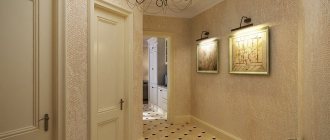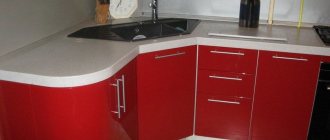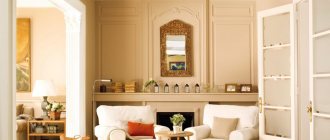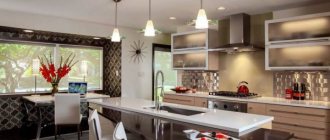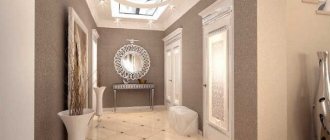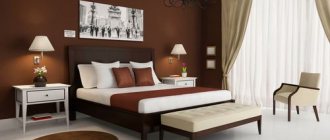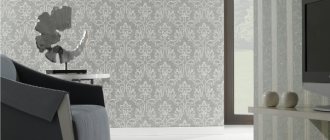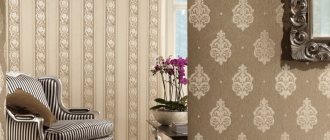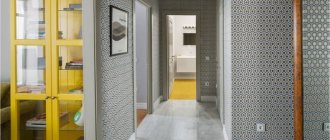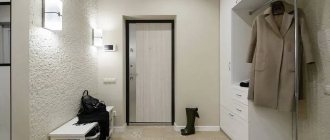The overall perception of the interior of a living space depends on the correct design of the hallway. It does not always receive as much design attention as other rooms, but it is the impression of the first room that a person enters that creates the basis for the perception of the entire home and owners.
Hallway interior design Source Design-homes.ru
Choosing the right wall color
In most cases, hallways are small. Basically, these are square or elongated rooms. The small area limits the choice, but there are criteria that should be taken into account:
- Area and layout of the premises. The smaller the hallway, the brighter the interior should be. A large corridor in a private house can be decorated in shades of dark colors, but for a small room it is worth choosing lighter shades.
- A stylistic direction that is used for interior design. Each style has characteristic features that you need to use to create a beautiful and stylish hallway.
- Features of the layout. In order to visually reduce a long corridor or increase the height of the ceilings, you should choose wallpaper with vertical stripes. To lengthen the room, a horizontal strip on the walls is suitable.
- Lighting affects the overall perception of the interior. Many corridors lack windows; the lack of natural light can be compensated for by placing artificial light sources. Good light will help highlight the color of the walls.
- It is not recommended to use more than 3 shades to decorate a hallway.
When choosing materials, it is worth considering the load on this functional area. Every day residents leave the house and return back. Depending on weather conditions, wet clothes, dirty shoes and wet umbrellas may appear in the hallway. Preference should be given to materials that are resistant to dirt and moisture. It would be appropriate to replace the snow-white shade of the walls with beige or cream.
Interior and lighting of the hallway Source Fashionable kitchen
What paints should I use?
To use paint and varnish material in a hallway or corridor, it is necessary to pay attention to the basic qualities and characteristics of the paint, since this will ensure long-term operation of the coatings, protect the walls from mechanical loads, the influence of liquids and other contaminants characteristic of this room.
Features of corridors and hallways:
- Location near the front door, which implies frequent sudden changes in microclimate and temperature, drafts. This destroys the coating with insufficient elasticity.
- Outerwear, shoes, umbrellas, and hats are often removed and left in the hallway or corridor. In bad weather, these things are often wet and dirty, which, as a result of moisture coming into contact with the walls, will directly put a load on the surface of the walls located close to the hangers. Paint and varnish coatings must have good wear resistance.
- Through the corridor and hallway, all objects enter the apartment: furniture, other large items. It is rarely possible to apply them without damaging the walls as a result of impact or friction, so the paint must form a durable film.
- Due to the openness of corridors and hallways to other rooms and spaces in the apartment, owners have to come into contact with evaporation from the walls, which should not be toxic or harmful. Intermediate spaces should be painted with paints intended for use in residential buildings.
Attention:
Paints for hallways and corridors must have such properties as vapor permeability, safety, moisture resistance, elasticity, strength, and wear resistance.
The best paints for decorating walls in hallways and corridors are water-dispersed paint compositions. They have all the necessary properties and are vapor permeable. Let's consider the types of this category of material.
Acrylic
High-quality but expensive paints and varnishes for interior decoration. They are resistant to direct exposure to UV radiation, vapor and moisture permeability, and film strength.
Due to its high drying speed and color retention, regardless of the operating conditions of the room, the paint forms a soft, even coating that can hide even small cracks as a result of painting.
Butadiene styrene
Budget materials that are suitable only for interior work in rooms exposed to moisture, liquids, and other contaminants on the walls. It is necessary to take into account that the paints of this series are not resistant to sunlight.
As a result of prolonged contact with UV radiation, surfaces painted with water-based butadiene styrene paints acquire a pronounced yellow tint.
Polyvinyl acetate
These paint and varnish compositions are cheap, with the most modest moisture resistance indicators. They should be used in rooms where contact with moisture is minimized.
Alkyd enamel
The peculiarity of the coloring composition is the presence of toxins of organic origin. When painting a room, a persistent, very unpleasant characteristic odor is created. To eliminate this effect, you need to intensively ventilate the treated rooms for at least 3-5 days.
You can find odorless alkyd enamels at a higher price due to the composition with polyurethane-based additives.
Universal colors, their features
The hallway connects the apartment or house with the outside world. Only the necessary furniture intended for storing clothes is placed in a small area. You can decorate the room by decorating the walls and using a small number of decorative elements.
As the main color, you should choose universal shades that look harmonious in any interior; you can easily match them with bright decor. The main color should occupy about 70% of the entire interior, the number of bright spots should not exceed 30%.
Universal shades that are perfect for hallway design include:
- light yellow;
- beige;
- sand;
- terracotta;
- cream;
- peach;
- mint;
- grey;
- pearl gray;
- coffee with milk;
- lilac.
Light gray walls in the hallway Source artsten.ru
Gray tones in combination with beige, many mirror surfaces, and white accents allow you to create a stylish interior. Gloss and many mirrors visually increase the space. Depending on what effect you want to achieve, you should decide what color to paint the corridor.
Warm shade for wall decoration Source mebelvdome.org
Shades of bright colors enliven the interior and give it a mood. Painted mustard walls highlight the neutral beige doors and brown wardrobe. Despite the lack of lighting, the hallway is warm and cozy.
The optimal solution for decorating a hallway is natural shades chosen for the base, and bright spots that dilute the boring design. The living space, the design of which is made in a single color scheme, looks stylish and complete.
The color difference allows you to harmonize the interior, which also gives the interior a sense of dynamics. For this purpose, various combined colors or several shades of the same color are suitable.
Size matters
When deciding on a color, take into account the area and configuration of the room. Unfortunately, most apartment owners cannot boast of a large hallway. Moreover, it is usually very small, or is a narrow corridor. It is in such situations that you will have to forget about painting the walls in your favorite dark chocolate color - it will visually “swallow” part of the space!
For a small hallway, the ideal option would be walls in one of the cool colors of the spectrum, which include:
The win-win of gray and beige lies in their neutrality. A neutral color is formed when a shadow falls on white - the result is gray. Gray mixed with yellow gives beige. The latter is called the ghost of the color palette: it is present in the material world, but no one notices it. Beige has no clear symbolism and does not actively participate in social, political or religious spheres.
Painting the walls gray or beige switches attention from form to content - a small hallway in neutral shades will seem a little larger than it actually is.
If you are lucky enough to own a home with a large hallway, then when choosing a color you can feel much freer and use a warm palette:
Classic style - colors for walls
When you need to design an interior that will remain relevant for a long time, you should give preference to the classic style. This direction is characterized by rigor, elegance and functionality. Natural materials are ideal for finishing and decorating a room:
- Fine wood or stone tiles, such as marble, are suitable for the floor.
- They make stucco on the ceiling.
- It is better to choose plaster cornices.
- For walls, paint with a matte finish, wallpaper with ornaments, and decorative plaster are suitable.
Interior design of a bright hallway Source design-homes.ru
Designers advise painting the walls in the hallway:
- white;
- gray;
- beige;
- olive;
- burgundy;
- brown;
- purple.
The classic style welcomes light and muted colors. Plain wallpaper, Venetian plaster, and paint are suitable for wall decoration. The hallway should be painted in a single color scheme; the material may contain a light pattern or design.
Carvings, columns and stucco will help complement the monochromatic design. Also, as decoration you can use natural materials, mirrors, luxurious wall lamps, which will be combined with the main lighting fixtures in the corridor.
Classic corridor design Source prihozhaya.guru
In the presented version, the walls are painted with beige paint, and black and white tiles with squares were used to decorate the floor. Mirrored cabinet doors increase the space and, by reflecting the flow of light, create interesting shimmers. To decorate the hallway, we hung a luxurious chandelier and installed a decorative vase in the corner.
Light shades are better than others for decorating a hallway in a classic style. In combination with light furniture and decorative elements, the interior looks luxurious and majestic.
Shades of dark colors can be used for spacious hallways. It is important to provide good lighting that will highlight the chosen wall color or pattern.
Interior design of a narrow corridor Source yellowhome.ru
The walls of a traditional classic hallway are predominantly light and warm. All details are harmoniously combined with each other; there are many unusual and beautiful decorative elements in the room. Neoclassicism is characterized by a wider range of colors. Contrasting colors and bright details can be used.
Materials for decorating hallway walls and their colors
When it is already approximately clear what exact shapes and sizes the furniture in the hallway will be, you should determine the optimal color setting for yourself. A little variety, but at the same time lightness and simplicity, will be provided by paints and relief plaster. The corridor will be white, orange, greenish, coffee color or some other color. But without color variety, unless you add stripes, color shifts or shade transitions. Cladding panels sometimes have no pattern at all, but the natural material usually retains a multi-colored structure, be it wood or stone. Tile coverings are also placed on the walls - with patterns or in various color combinations. Art lovers should choose a design with murals or photo wallpaper. A “corner” of picturesque nature will not be out of place, as will the atmosphere in the spirit of the Middle Ages with its inherent shades.
Painting the walls
The shade on the wall becomes less saturated than in the container - you should remember this so that you don’t end up with a dull and watery color instead of a light one. Painted walls are almost always monotonous - this is not bad for a narrow corridor, but in a large one such decoration will turn out to be boring. Stencils will help: they are used to make drawings and lines. The second option will be acceptable, especially since vertical and horizontal stripes on the walls can correct uneven ceilings, as well as visually expand the room in different directions. If we talk specifically about the white color, then the paint will have to be protected from dirt and cleaned of it. Dirt and grease easily stick to pigments. These worries can be avoided if you decorate the corridor in light colors: peach, beige, light coffee. At the same time, you will have to take less care of wallpaper and panels in white.
kitchens with white glossy facades and wooden countertops
Wallpapers and photo wallpapers
It is better to abandon paper ones, for example, in favor of non-woven ones. There is no better option than buying paintable wallpaper in white. Their structure has an attractive and technological appearance. The color can be changed at any time. The hallway will look better with a white color at the front door and a bright color closer to other rooms. The passage to each room will be decorated with stripes around the door frames. In addition, you can make a chaotic mosaic with colored inserts in accordance with the shapes on the wallpaper. The hallway is a great place for photo wallpaper. They decorate a small part of the room and change it periodically. Photo wallpaper is an effective way to visually increase space. An image from a certain angle will expand the hallway in a particular place. Natural motifs are selected for the canvases: sea, flowers, gardens, forests, animals, clouds. A good alternative would be black and white prints from photos and drawings.
Paneling
Panels are made from MDF and chipboard boards, which are “transformed” into a structural pattern with changing colors. Moreover, the stripes on the slats themselves will be very useful - you should not focus only on ideal monotonous specimens. In addition to shades of brown, white surfaces and lines are used in the hallway. Panels are also made from natural stone with or without a relief surface. There are more and more wooden and stone models lately. Some products are given a 3D structure and used to enhance decorativeness. The corridor will be decorated with solid panels in the form of a honeycomb, despite the reduction in free space. The color range of textured slabs includes brown, gray, white, red and blue tones. Mirror panels are made from different materials and types of reflective coating. Silver and gold colors are popular.
MDF panels are fixed in one of the following ways:
When choosing between MDF and chipboard, you should choose the first, more environmentally friendly option.
Textured plaster
For a conventional design, bark beetle is suitable, and for a classic and elegant interior - Venetian. The first type is, in principle, used everywhere. Due to the peculiarities of the composition and different movements, grooves are formed on the bark beetle, from which both chaotic and more meaningful patterns can be collected. The traditional range of plaster, named after the bark beetle, includes orange, light green, pink, yellow colors, but they are pale and dirty. White is used in dark rooms. Dark red - in spacious halls. Venetian trim contains chips of precious stones, and its color depends on these inclusions. In this case, the pits turn out to be flat. The color palette of Venetian plaster includes greenish, golden, yellow-orange, pink and white tones. The coating has light and dark areas, so any color is suitable for a light version of the corridor.
Ceramic tiles and stone
As for ceramic tiles, the usual flat version remains popular despite the trend towards the use of textured products. Embossed ones give the interior exclusivity and improve the perception of monotonous coverings. Standard flat tiles benefit from their pattern. There are almost no prints on relief products. The walls of the hallway are decorated with material with floral images in different versions. The interior is complemented with objects with ethnic motifs from all nations of the world. The stone looks equally good as a solid continuous coating, and as an element when fastened in fragments. The “brickwork” option is suitable for a simple design. The seams between the tiled elements dilute the boring solidity of the walls, so that the expensive interior is even better in terms of aesthetics. Natural stone is replaced with artificial stone if there is a need to save money, and the benefits are quite large.
Decoration and decoration with frescoes
Frescoes are used to cover tiled surfaces, but this is also an independent option for finishing. Picturesque landscapes are combined with luxurious chandeliers of a classic interior and forms of modern furnishings. They improve the color scheme and psychological perception of the room. The fresco technology itself involves painting on wet plaster with the subsequent formation of a calcite film, which gives a special shade and, in addition, guarantees the stability of the painting. However, it is not necessary to follow these canons exactly. Frescoes in the broad modern sense are also painted using the alsecco technique. In this case, they work on dried plaster. The task is sometimes simplified even further, and they paint on any surface with water-based paints based on powder pigments. The traditional colors for frescoes were and remain red, orange and brown.
Choosing a color for a narrow hallway
The main task of designing a narrow hallway is the correct placement of furniture and visual expansion of the space. Light color of the walls and ceiling will help to visually raise the ceiling. Enlarged doorways will add solemnity to a narrow hallway.
By using zoning for the entrance and lobby areas, you can create the correct proportions in the room. Different stylistic directions, light, color, floor and ceiling finishing will allow you to highlight functional areas.
Hallway in blue: creating an interior in heavenly tones
Creating the interior of a hallway is one of the most difficult issues for the owner. It will definitely be difficult to please yourself and all your roommates and guests, but this is the main task. After a hard day at work, there is always a desire to relax and plunge into a more cozy and comfortable atmosphere. Often the hallway serves as a transit point, and not just a reception area. The owners prefer to relax in the bedroom late at night; the hallway is almost always visible, because people spend most of their time relaxing in the living room. And between the living room and the hallway in our Russian outbacks there is only one step.
Blue and pink: a compromise of contradictions
At first glance, seemingly poorly combined tones actually complement each other effectively and stylishly. A delicate pink top with deep blue along the floor is suitable for rooms with low ceilings; shades of peach with vertical inserts of blue planes will visually expand the walls.
The blue color in the hallway interior will balance out the bright pink
: this solution is relevant for a room in avant-garde styles. Based on this duet, you can create stunning hallways in the Empire or Art Deco style, if you decorate the pink walls with fancy dark blue accessories.
Working with blue in the interior of a hallway is both complex and exciting. Self-sufficient blue can be simple and multifaceted, unobtrusive and actively expressing itself. In a word, he will become the way the master sees him. If, after studying all the options, a blue hallway has transformed from a vague dream into a specific goal, feel free to set about realizing it.
The WESTWING shopping club will support you with advice and pleasant bonuses: club subscribers receive designer accessories and interesting elements for their future dream hallway at a serious discount.
